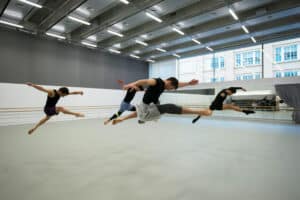Alastair Macaulay has been out reviewing student productions:
Three British choreographers: Ashton, Alston, Wheeldon
One theatre critic used to boast that he never reviewed amateurs. I’ll concede that many amateur performances aren’t worth reviewing, but you have only to watch the performance-arts schools of London and New York to see that much more than talent-spotting is involved. Often a work comes into a kind of precise focus that’s missing from professional performances, especially with complex ensembles. A number of groups exist with performers in a special transition between student and professional status. And our conservatories often show a keener sense of heritage than our professional troupes.
This week, Ballet Central – attached to London’s Central School of Ballet – presented a quadruple bill at Covent Garden’s Linbury Studio Theatre. One of its works, Kristen McNally’s “Feast”, seemed tailor-made to its performers’ abilities, while two others (Dickson Mbi’s “Rise” and Thick & Tight’s “Keeping Up with the Apocalypse”) efficiently presented idioms that seemed slickly of the moment. But the programme also contained a reconstruction of a long-lost ballet by Frederick Ashton, “Foyer de Danse” (1932), a reimagination of the ballet studios painted by Degas.
Shouldn’t this have seemed the most outdated and faded work on the programme? Yet the opposite proved true: each young woman in the corps de ballet of six became a compelling individual, vividly pointedly bringing her own character to the classroom, while Hannah Noh (as the Étoile, a role created by Alicia Markova) exuded finesse, wry humour, and casual brilliance (the timing and flourish of her turns is charm itself) while in Ashton’s own role as the maître de ballet Joseph Burdett youthfully showed dance sparkle and wit of equal calibre, his feet and legs chattering in the air with absurd elegance. Even Hugh Lewis, in the “abonné” role (created by Walter Gore) virtually without dance, emerged with a distinctness that was never to be found in any of the other three works.
This is a tribute to Ashton’s particular genius for showing dancers how to find their theatrical personalities within the exacting challenges of ballet – and it’s also a tribute to Ursula Hageli, the former ballet mistress of the Royal Ballet, who has spent years in recreating “Foyer de Danse” by studying the fragments of silent film of Marie Rambert’s original cast and the score. But for those of us who have hitherto only known “Foyer de Danse” from the silent film foothage, the big surprise and fascination of this Ballet Centeal production lie in its music and musicality. You’d think that Ashton would have concocted his Degas pastiche to nineteenth-century French ballet music (for which he anyway had an affinity) – but no. Instead he fitted his vision to a surrealist score, “Luna Park”, composed two years before by his friend Lord Berners. Berners had written it for George Balanchine to stage in a 1930 Charles Cochran revue. Luna Park was a place in St Petersburg known to Balanchine: Berners had already composed “The Trumph of Neptune” for Balanchine and Diaghilev in 1926; his and Balanchine’s was an exercise in surrealism and metatheatrics, with “freaks” contrasted with non-freaks, performance roles contrasted with living dancers. In Ashton’s “Degas” staging, this surrealism became a gentler interplay – between rehearsal and performance, class and delivery – adding an intriguing element of spice. We can occasionally question whether Hageli has always made the right connection of movement and music, but there’s no doubt that the Central dancers come into their own in these conditions, with Ashton/Hageli helping them to marry phrases of dance and phrases of music.
Ashton was really the founder choreographer of what is now the Rambert Dance Company. And although he alone became the resident choreographer instead of what became the Royal Ballet, there was a happy period at the end of his life when Ballet Rambert, then directed by the choreographer Richard Alston, revived two Ashton creations. Even though Alston has been mainly a modern-dance choreographer working with barefoot dancers, there was and is a profound kinship between these two men: a love of nimble footwork and pliant torsos, keen musicality based in rhythmic play and melodic phrasing, with a complexity of architecturally linear shapes that often matched the music’s harmonic tensions. Now that Alston no longer has a dance company (thanks to the ill-named Arts Council), it’s the Rambert Academy, in Twickenham, that does most to revive his choreography (even commissioning some new works): several of its staff teach classes based in the “Alston technique”, an idiom he himself began to develop in the late 1970s and which he made the laboratory for his own choreography. In April, the Rambert Academy presented a programme in which perhaps half the fare was by Alston. There again, in works to music by both Brahms and Steve Reich, were the rhythmic drive, the linear clarity, and the gracefully purposeful phrasing that have characterised Alston’s dances for almost fifty years. If only Britain had companies – ha!- that acted as custodians of British dance repertory, the country’s dance-goers would be able to take pride in a wide and rich range of this.
During this century, Christopher Wheeldon has made a trio of three-act narrative ballets for the Royal Ballet at Covent Garden: “Alice’s Adventures in Wonderland” (2011), “The Winter’s Tale” (2014), “Like Water for Chocolate” (2022), each with music by Joby Talbot, designs by Bob Crowley, lighting by Natasha Katz. At present, “Alice’s Adventures” and “Winter’s Tale” look well set to become enduring parts of Royal repertory. Not, however, with me in the audience.
These three ballets are triumphs of Crowley’s design mastery. Wheeldon emerges as a master of dance vocabulary and lively characterisation – but without any depth. The obvious problem in all three is Talbot’s music, which is skilful but tasteless hackwork, adding noise and colour but never poetry of any eloquence.
“Winter’s Tale” is much the best of the trio: I’m struck by the Covent Garden programme essay on Wheeldon that claims Wheeldon here “created a full-evening work after Shakespeare that is arguably more satisfying than the original play”. (Discuss the words “arguably” and “satisfying”.) You don’t need to know Shakespeare’s play very welll to realise he wasn’t trying to write a satisfying work of art. Decades pass in its course, vital characters die, the protagonist Leontes often speaks impenetrably under the weight of jealousy.
“Alice” draws its characters and plot from Carroll’s fabulously eccentric fantasy; its also draws from Jonathan Miller and others in basing the narrative in the Oxford world that inspired it. But Wheeldon was once an of more humanity and imagination than this. His “Alice” feels like Lewis Carroll tourist merchandise.
@Alastair Macaulay, 2025
The post Sometimes it takes kids to put big names to shame appeared first on Slippedisc.








